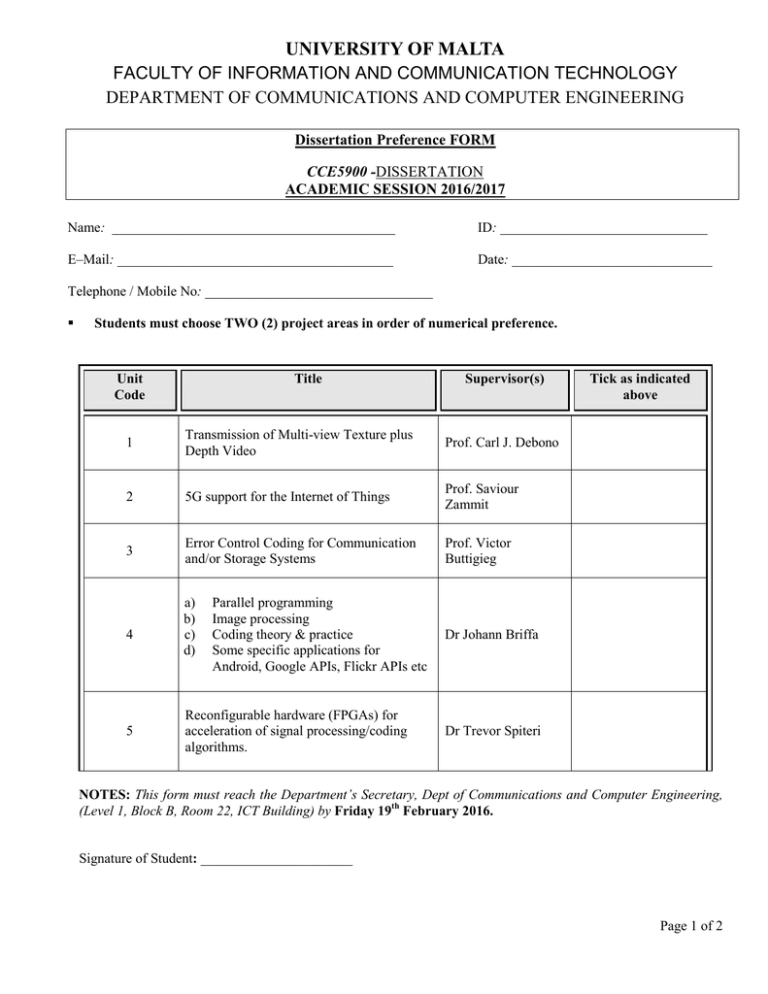UNIVERSITY OF MALTA FACULTY OF INFORMATION AND COMMUNICATION TECHNOLOGY
advertisement

UNIVERSITY OF MALTA FACULTY OF INFORMATION AND COMMUNICATION TECHNOLOGY DEPARTMENT OF COMMUNICATIONS AND COMPUTER ENGINEERING Dissertation Preference FORM CCE5900 -DISSERTATION ACADEMIC SESSION 2016/2017 Name: _________________________________________ ID: ______________________________ E–Mail: ________________________________________ Date: _____________________________ Telephone / Mobile No: _________________________________ Students must choose TWO (2) project areas in order of numerical preference. Unit Code Title Supervisor(s) 1 Transmission of Multi-view Texture plus Depth Video Prof. Carl J. Debono 2 5G support for the Internet of Things Prof. Saviour Zammit 3 Error Control Coding for Communication and/or Storage Systems Prof. Victor Buttigieg 4 5 a) b) c) d) Parallel programming Image processing Coding theory & practice Some specific applications for Android, Google APIs, Flickr APIs etc Reconfigurable hardware (FPGAs) for acceleration of signal processing/coding algorithms. Tick as indicated above Dr Johann Briffa Dr Trevor Spiteri NOTES: This form must reach the Department’s Secretary, Dept of Communications and Computer Engineering, (Level 1, Block B, Room 22, ICT Building) by Friday 19th February 2016. Signature of Student: ______________________ Page 1 of 2 Details on proposals Supervisor Prof. Carl J. Debono Area/s Transmission of Multi-view Texture plus Depth Video Multi-view texture plus depth video is a possible transmission format for auto-stereoscopic displays and free-viewpoint television. In this format, the natural scene is captured through multiple cameras. The depth information can be either captured using depth sensors, such as time-of-flight sensors, or generated from two views using signal processing techniques. All the captured data has to be encoded and transmitted on bandwidth-limited channels. Intermediate views are then generated using the texture and the depth data together with the camera calibration parameters. The state-of-the-art standard is 3D-HEVC. More Details Possible aspects that can be tackled in this projects are: improvement in coding strategy, performance of the transmission of such content on networks (such as LTE-Advanced, Software-defined Networks, Network Functions Virtualization technologies, InformationCentric Networks, Cloud, etc.), or free-viewpoint system architectures. Supervisor Prof. Saviour Zammit Area/s 5G support for the Internet of Things More Details This area of study is concerned with how IoT requirements are influencing the design of the next generation 5G network. Supervisor Prof. Victor Buttigieg Area/s Error Control Coding for Communication and/or Storage Systems More Details This includes code construction techniques and optimal and sub-optimal decoding algorithms. Supervisor Dr Johann Briffa a) Parallel programming b) Image processing c) Coding theory & practice d) Some specific applications for Android, Google APIs, Flickr APIs etc Area/s More Details More information can be found at the below link: https://jabriffa.wordpress.com/research/topics/ Supervisor Dr Treovr Spiteri Area/s Reconfigurable hardware (FPGAs) for acceleration of signal processing/coding algorithms. More Details There are several signal processing and coding algorithms that are computationally intensive, for example image processing and video coding algorithms can be quite complex. For real-time operation of these algorithms, one way to accelerate the algorithms is to use reconfigurable hardware, namely FPGAs. FPGA use makes sense when the algorithm can be divided into parts that can run in parallel, as FPGAs support high parallelization. A project in this area would focus on the acceleration of such an algorithm using FPGAs. Page 2 of 2


